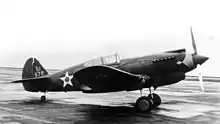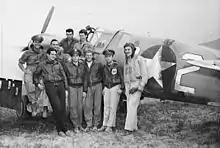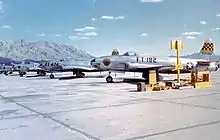57th Operations Group
The 57th Operations Group (57 OG) is a non-flying component of the 57th Wing, assigned to the United States Air Force's Air Combat Command. The group is stationed at Nellis Air Force Base, Nevada.
| 57th Operations Group | |
|---|---|
 A Predator Unmanned Aerial Vehicle of the group while deployed to Afghanistan | |
| Active | 1941–1945, 1946–1953, 1961–1968, 1991–present |
| Country | |
| Branch | |
| Role | Fighter; Operational Test and Evaluation |
| Part of | Air Combat Command |
| Garrison/HQ | Nellis Air Force Base |
| Motto(s) | First in the Blue |
| Engagements | Mediterranean Theater of Operations |
| Decorations | Distinguished Unit Citation Air Force Outstanding Unit Award French Croix de Guerre with Palm |
| Insignia | |
| 57th Operations Group emblem[1][2] |  |
| Patch with 57th Fighter Group emblem (Approved 2 February 1950)[3] |  |
The Group provides direct oversight of the Nellis flying mission through the 57th Operations Support Squadron. They manage the airfield, operate the air traffic control tower, and the Nellis Air Traffic Control Facility providing radar service to local flying operations and the National Airspace System. It is responsible for scheduling, training, life support, weapons, tactics and planning staff functions. In addition to these functions, it also maintains administrative oversight of the 57th ATG staff and the 57th Wing staff. The 57th OG also directs execution of two of the world's premier combat training exercises, Red Flag and Green Flag.
Units
The 57th Operations Group became a non-flying organization when on 1 July 2005, the flying squadrons of the 57 OG were split off into the new 57th Adversary Tactics Group; but will change again in September when the 30th Recon Squadron was activated for UAV Sentenals. As of 2 March 2018 the group flies F-16's assigned to the 24 TASS.
Current units assigned to the group are:
- 6th Combat Training Squadron
- Both the squadron at Nellis and Det. 1, 6th CTS at Fort Sill, Oklahoma, provide academic instruction in air ground operations through the Joint Firepower Course (JFC), the Air Liaison Officer Qualification Course (ALOQC), the Air Support Operations Center Initial Qualification Course (ASOCIQC), the Joint Terminal Attack Controller Qualification Course (JTACQC), and the Joint Forward Air Controller (Airborne) Qualification Course (JFAC(A)). Det. 1, 6th CTS conducts Joint Fires Observer Qualification Course (JFO) for U.S. Army fire support personnel.
- Activated on 2 March 2018, the 24 TASS flies F-16 Fighting Falcon's in support of the USAF's focus on CAS and joint operations. The squadron is the schoolhouse for Forward Air Controller-Airborne (FAC-A) course.
- 57th Operations Support Squadron
- A functionally diverse squadron of nearly 200 personnel organized in four flights: Weapons and Training, Current Operations, Weather and Airfield Operations. Responsible for all airfield operations support at Air Combat Command's busiest and most complex base. Provided trained and qualified personnel to operate the USAF's largest air traffic control (ATC) complex. Integrated operations from three wings, four groups, and eleven squadrons, ensuring successful wing programs to include operational plans, scheduling, training, and munitions allocation.
- 12th Combat Training Squadron
- Located at the U.S. Army's National Training Center, Fort Irwin, California The unit is designated "Team Raven" within the NTC operations group. The mission of Team Raven is threefold. Execute the Air Combat Command-sponsored Green Flag West exercise, acts as the division liaison element for the NTC operations group and deployed brigade tactical air control parties, and conduct training while simultaneously providing weather support for the NTC med-evac missions at Fort Irwin.
- Conducts RED FLAG-Nellis on the Nevada Test and Training Range involving USAF aircraft and the aircraft of many different allied nations.
- 548th Combat Training Squadron (Green Flag East)
- Execute the Air Combat Command-sponsored Green Flag East exercise, providing operational control, safe employment and realistic training for all Air Force participants at the U.S. Army Joint Readiness Training Center, Fort Polk, La
- 549th Combat Training Squadron (Green Flag West)
- Execute the Air Combat Command-sponsored Green Flag West exercise, providing operational control, safe employment and realistic training for all Air Force participants at the National Training Center, Fort Irwin, Calif
History
- See 57th Wing for associated lineage and timeline information.
World War II



The group was first activated as the 57th Pursuit Group in January 1941, flying P-40 Warhawks as part of the Army Air Corps Northeast Defense Sector (later assigned to the I Fighter Command) at Mitchel Field, New York.[3] It trained in New England and provided air defense of the northeast after the Japanese attack on Pearl Harbor. It was redesignated as the 57th Fighter Group (FG) in May 1942.[3]
The 57th FG was reassigned to the U.S. Army Middle East Force in Egypt. In June 1942 the pilots and 72 new P-40Fs loaded aboard the aircraft carrier Ranger at Quonset Point, Rhode Island, sailing 1 July. On 19 July, off the Gold Coast, they launched in four sections of 18 aircraft and flew to Accra, thence across Equatorial Africa to Palestine, officially becoming part of IX Fighter Command. However, prior to the group officially commencing operations, individual 57th FG pilots were attached to, and flew combat sorties with, P-40 squadrons of the Royal Air Force (RAF), South African Air Force (SAAF) and Royal Australian Air Force (RAAF), belonging to No. 211 Group, Desert Air Force.[3]
In October 1942, the 57th FG officially began combat operations as a formation. The group took part in the Battle of El Alamein and, as part of Ninth Air Force, supported the Commonwealth Eighth Army's drive across Egypt and Libya, escorting bombers and flying strafing and dive-bombing missions against airfields, communications, and troop concentrations until Axis defeat in Tunisia in May 1943. The unit participated in the reduction of Pantelleria (May–June 1943) and the conquest of Sicily (July–August 1943). For front-line operations in direct support of the Eighth Army from the Battle of El Alamein to the capitulation of enemy forces in Sicily, the group received a Distinguished Unit Citation (DUC).[3]
In an aerial battle over the Gulf of Tunis at Cape Bon in April 1943, the group destroyed approximately 74 of the enemy's transport and fighter aircraft[3] while sending an equal number down to the sea and beaches to escape by crash landing. The 57th lost just six aircraft in this melee. Forever known by the 57th as the 18 April 1943 Goose Shoot – "The Palm Sunday Massacre," it received another DUC[3] and it added four newly created aces. This action broke the German's aerial supply line and they surrendered Tunisia thirty days later.
The 57th supported the British Eighth Army's landing at Termoli and subsequent operations in Italy, being reassigned to Twelfth Air Force in August 1943.[3] It flew dive-bombing, strafing, patrol, and escort missions.
Early in 1944, the group converted to P-47 Thunderbolt aircraft and flew interdiction operations in Italy.[3] The group moved to Corsica on 30 March 1944 to operate as a separate task force. It flew interdiction missions against railroads, communication targets, and motor vehicles behind enemy lines, providing a minimum of 48 fighter-bomber sorties per day. During 9 days of combat operations during early April 1944, the 57th exceeded 50 sorties per day. While the group was stationed on Corsica, director William Wyler made a 45-minute long Technicolor documentary film, Thunderbolt!. filming combat missions of the 57th. The film concentrated on Operation Strangle. The film was released for the military in 1945 and for general release in 1947.[4]
The group earned a third DUC c. 14 April 1944 for attacks in the Florence-Arezzo area. The group participated in the French campaign against Elba in June 1944 and in the invasion of Southern France in August.[3] It engaged in interdiction and support operations in northern Italy from September 1944 to May 1945. For its operations in the Mediterranean Theater of Operations, the 57th earned the French Croix de Guerre with Palm (awarded in late 1967).[1] It was inactivated on 13 April 1953.[3]
The group remained in northern Italy after the end of the European War, demobilizing throughout the summer of 1945. It was reassigned to the United States in August 1945 and was inactivated at the end of August.[3]
Cold War

The group was reactivated in August 1946 and assigned to Alaskan Air Command[3] as part of the air defense forces in the northwest Pacific. The group assumed the mission, personnel and equipment of the 343d Fighter Group, which was simultaneously inactivated at Shemya Army Air Base.[5] It provided air defense initially in the Aleutian Islands, then moved in 1947 to Elmendorf Air Force Base. In 1948, as a result of the wing/base reorganization of the Air Force (Hobson Plan), the group became part of the 57th Fighter Wing, which included three support groups in addition to the group.[3] In January 1950, it was redesignated as the 57th Fighter-Interceptor Group. In January 1951, its parent 57th Fighter-Interceptor Wing inactivated, although the group remained active as part of the AAC air defense until 1 November 1952 when its personnel were reassigned and it became a paper unit.[1] It was inactivated on 13 April 1953.[3]
The group was reactivated at Paine Field, WA as the 57th Fighter Group (Air Defense) and assigned to Air Defense Command's Seattle Air Defense Sector, assuming the equipment and personnel of the 326th Fighter Group, which was simultaneously inactivated. It was assigned the 64th Fighter-Interceptor Squadron, which was already at Paine with the 326th flying Convair F-102 Delta Daggers[6] as its operational element and also several support units as it assumed USAF host unit duties at Paine.[7][8][9][10] It provided air defense over the Pacific Northwest. In June 1966, it briefly became non-operational when its 64th Squadron moved to Southeast Asia and was assigned away from the group. However, after two weeks, the 498th Fighter-Interceptor Squadron, flying Convair F-106 Delta Darts,[11] moved to Paine and became the group's new operational squadron. It was inactivated 30 September 1968[1] when Air Defense Command closed its facilities at Paine AFB.
From 1991
On 1 November 1991, the group was redesignated the 57th Operations Group and activated[1] as a result of the 57th Fighter Wing implementing the USAF objective wing organization. The 57 OG was assigned control of the wing's tactical units.
Upon activation, the 57th OG managed Air Force tactical training through Red Flag and Air Warrior exercises.[1] Between July 1995 and March 2002, the group gained the three MQ-1 Predator reconnaissance squadrons.[1] The Group deployed the Predator elements of the 11th and 15th Squadrons in support of operations in Bosnia (April 2000), Kuwait (October 2000), and Pakistan, September 2001 – January 2002 in support of Operation Enduring Freedom.[1] The 57th Group's 66th Helicopter Squadron also deployed for operations in Northern Watch and Enduring Freedom.[1] While at Nellis, the Group continued to provide air combat units for US and Allies with realistic, large force combat training at Red Flag.[1]
From 1 July 2005 to 1 March 2018 the group was non-flying as the flying squadrons of the 57th were split off into the new 57th Adversary Tactics Group, which consolidated all Aggressor activities under one group to provide the Combat Air Forces with the opportunity to train against a realistic, fully integrated threat array during large- and small-scale exercises such as Red Flag – Nellis, Red Flag – Alaska, Maple Flag, Green Flag and dissimilar air combat training deployments.
On 2 March 2017 the group activated the 24th Tactical Air Support Squadron and once again is flying the F-16.
Lineage
- Constituted as the 57th Pursuit Group (Interceptor) on 20 November 1940
- Activated on 15 January 1941
- Redesignated as 57th Fighter Group (Single Engine) on 15 May 1942
- Inactivated on 7 November 1945
- Activated on 15 August 1946
- Redesignated as 57th Fighter-Interceptor Group on 20 January 1950
- Inactivated on 13 April 1953
- Redesignated as 57th Fighter Group (Air Defense) and activated on 24 February 1961 (not organized)
- Organized on 1 April 1961
- Discontinued and inactivated on 30 September 1968
- Redesignated as 57th Fighter Weapons Group on 31 July 1985 (remained inactive)
- Redesignated as 57th Operations Group on 1 November 1991 and activated[1]
Assignments
|
|
Components
|
Operational Squadrons
|
|
Stations
|
|
Aircraft assigned
|
|
Awards
![]()
- Distinguished Unit Citation[3]
- North Africa and Sicily, 24 October 1942 – 17 August 1943
- Tunis and Cape Bon Area, 18 April 1943
- Italy, 14 April 1944
![]()
- Air Force Outstanding Unit Award[3]
- 1 January 1995 – 31 May 1997
- 1 June 1998 – 31 May 2000
- 1 June 2001 – 31 May 2003
- 1 June 2003 – 31 May 2004
- 1 June 2004 – 31 May 2006
![]()
- French Croix de Guerre with Palm, October 1942 – May 1945
![]()
- European-African-Middle Eastern Theater
- Campaigns[3]
- Air Combat, EAME Theater
- Egypt-Libya
- Tunisia
- Sicily
- Naples-Anzio
- Rome-Arno
- Southern France
- Northern Apennines
- Po Valley
References
Notes
- Robertson, Patsy (27 July 2009). "Factsheet 57 Operations Group (ACC)". Air Force Historical Research Agency. Archived from the original on 18 January 2018. Retrieved 18 January 2018.
- The 57th Operations Group uses the 57th Wing emblem with the group name on the scroll. Robertson, AFHRA Factsheet, 57 Operations Group.
- Maurer, Combat Units, pp. 120–121
- YouTube Movie, "Thunderbolt". Retrieved 20 May 2012
- Maurer, Combat Units, 221–222
- Cornett & Johnson, p. 118
- "Abstract, History 57 Dispensary Jul–Dec 1962". Air Force History Index. Retrieved 20 May 2012.
- "Abstract, History 57 Combat Support Squadron 1958–1968". Air Force History Index. Retrieved 20 May 2012.
- Cornett & Johnson, p. 137
- Cornett & Johnson, p. 145
- Cornett & Johnson, p. 130
Bibliography
![]() This article incorporates public domain material from the Air Force Historical Research Agency website http://www.afhra.af.mil/.
This article incorporates public domain material from the Air Force Historical Research Agency website http://www.afhra.af.mil/.
- Cornett, Lloyd H; Johnson, Mildred W (1980). A Handbook of Aerospace Defense Organization, 1946 – 1980 (PDF). Peterson AFB, CO: Office of History, Aerospace Defense Center. p. 118.
- Maurer, Maurer, ed. (1983) [1961]. Air Force Combat Units of World War II (PDF) (reprint ed.). Washington, DC: Office of Air Force History. ISBN 0-912799-02-1. LCCN 61060979.
- Ravenstein, Charles A. (1984). Air Force Combat Wings, Lineage & Honors Histories 1947-1977. Washington, DC: Office of Air Force History. ISBN 0-912799-12-9.\
External links
- Nellis AFB Home Page
- 57th Wing
- Official website of the 57th Fighter Group
- 57th Fighter Group
- 57th Fighter Group Exhibit at the New England Air Museum
- "AF to grow, enhance Nellis group with close air support focus". Air Force News Service. 16 August 2016. Retrieved 19 August 2016.



.jpg.webp)
.svg.png.webp)